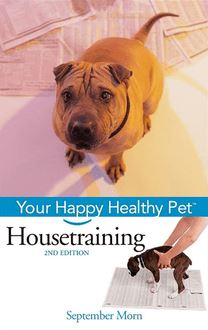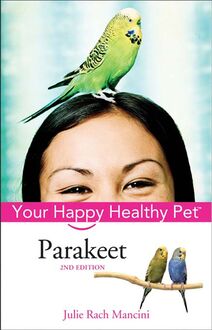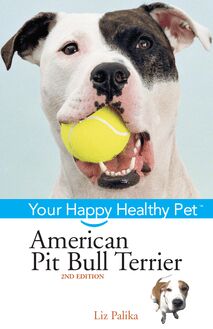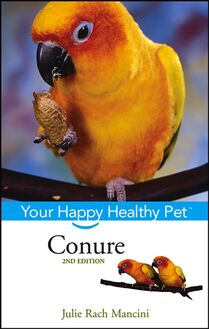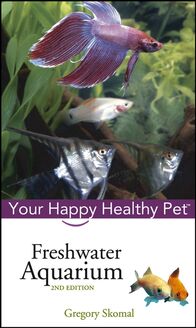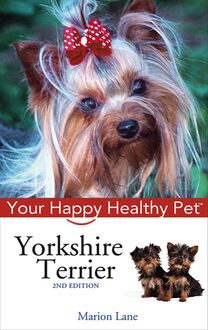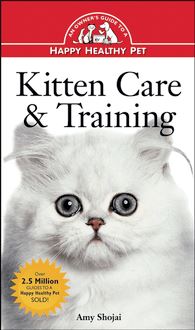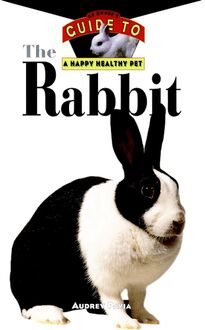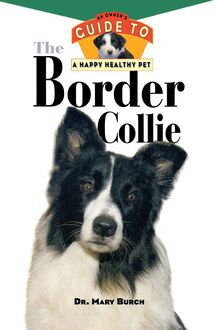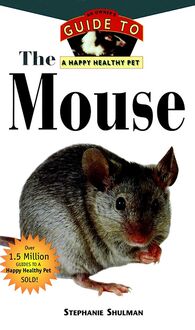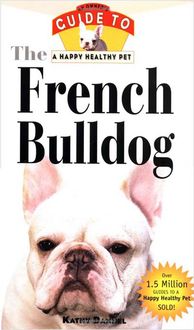-
 Univers
Univers
-
 Ebooks
Ebooks
-
 Livres audio
Livres audio
-
 Presse
Presse
-
 Podcasts
Podcasts
-
 BD
BD
-
 Documents
Documents
-
- Cours
- Révisions
- Ressources pédagogiques
- Sciences de l’éducation
- Manuels scolaires
- Langues
- Travaux de classe
- Annales de BEP
- Etudes supérieures
- Maternelle et primaire
- Fiches de lecture
- Orientation scolaire
- Méthodologie
- Corrigés de devoir
- Annales d’examens et concours
- Annales du bac
- Annales du brevet
- Rapports de stage
La lecture à portée de main
Vous pourrez modifier la taille du texte de cet ouvrage
Découvre YouScribe en t'inscrivant gratuitement
Je m'inscrisDécouvre YouScribe en t'inscrivant gratuitement
Je m'inscrisEn savoir plus
Vous pourrez modifier la taille du texte de cet ouvrage
En savoir plus

Description
* Expert authors, plus renowned guest contributors on specialized topics
* Full-color photos throughout
* Basic information on the breed, species, or topic
* Complete coverage of care, health, grooming, training, and more
* Tips and techniques to make life with a pet more rewarding
PART ONE: Welcome to the World of the Beagle.
1. What Is a Beagle?
2. The Beagle's Ancestry.
3. The World According to the Beagle.
PART TWO: Living with a Beagle.
4. Bringing Your Beagle Home.
5. Feeding Your Beagle.
6. Grooming Your Beagle.
7. Keeping Your Beagle Healthy.
PART THREE: Enjoying Your Dog.
8. Basic Training (Ian Dunbar, Ph.D., MRCVS).
9. Getting Active with Your Dog (Bardi McLennan).
10. Your Dog and Your Family (Bardi McLennan).
11. Your Dog and Your Community (Bardi McLennan).
PART FOUR: Beyond the Basics.
12. Recommended Reading.
13. Resources.
Sujets
Informations
| Publié par | Turner Publishing Company |
| Date de parution | 05 mai 2008 |
| Nombre de lectures | 0 |
| EAN13 | 9780470369555 |
| Langue | English |
| Poids de l'ouvrage | 2 Mo |
Informations légales : prix de location à la page 0,1000€. Cette information est donnée uniquement à titre indicatif conformément à la législation en vigueur.
Extrait
The
Beagle
Howell Book House
Howell Book House A Simon Schuster Macmillan Company 1633 Broadway New York, NY 10019
Copyright © 1996 by Howell Book House All rights reserved. No part of this book may be reproduced or transmitted in any form or by any means, electronic or mechanical, including photocopying, recording, or by any information storage and retrieval system, without permission in writing from the Publisher.
MACM1LIAN is a registered trademark of Macmillan, Inc.
Library of Congress Cataloging-in-Publication Data Roth, Richard. The beagle: an owner’s guide to a happy, healthy pet/Richard Roth. p. cm. Includes bibliographical references.
ISBN: 0–87605–389–4
1. Beagles (Dogs) I. Title. SF429.B3R68 1996 636.7’53—dc20 95–41273 CIP
Manufactured in the United States of America 10 9 8 7 6
Series Director: Dominique De Vito Series Assistant Director: Ariel Cannon Book Design: Michele Laseau Cover Design: Iris Jeromnimon Illustration: Jeff Yesh Photography:
Cover. Judith Strom, adult and puppy
Courtesy of the American Kennel Club: 14
Joan Balzarini: 96
Mary Bloom: 19, 25, 28, 36-37, 80, 136, 145
Paulette Braun/Pets by Paulette: 2-3, 5, 45, 46, 49, 57, 60, 63, 75
Buckinghamhill American Cocker Spaniels: 148
Sian Cox: 134
Dr. Ian Dunbar: 98, 101, 103, 111, 116-117, 122, 123, 127
Dan Lyons: 96
Scott McKiernan: 7, 8, 9, 23, 44, 56, 62, 94
Cathy Merrithew: 129
Liz Palika: 133
Janice Raines: 132
Susan Rezy: 96-97
Richard Roth: 12, 20, 27, 53
Judith Strom: 11, 21, 29, 31, 32, 38, 40, 41, 42, 55, 58, 66, 96, 107, 110, 128, 130, 135, 137, 139, 140, 144, 149, 150
Kerrin Winter Dale Churchill: 96-97
Production Team: Trudy Brown, Jama Carter, Kathleen Caulfield, Trudy Coler, Amy DeAngelis, Pete Fornatale, Matt Hannafin. Kathy Iwasaki, Vic Peterson, Terri Sheehan, Marvin Van Tiem, and Kathleen Varanese
Contents
part one
Welcome to the World of the Beagle
1 What Is a Beagle?
2 The Beagle’s Ancestry
3 The World According to the Beagle
part two
Living with a Beagle
4 Bringing Your Beagle Home
5 Feeding Your Beagle
6 Grooming Your Beagle
7 Keeping Your Beagle Healthy
part three
Enjoying Your Dog
8 Basic Training by Ian Dunbar, Ph.D., MRCVS
9 Getting Active with Your Dog by Bardi McLennan
10 Your Dog and Your Family by Bardi McLennan
11 Your Dog and Your Community by Bardi McLennan
part four
Beyond the Basics
12 Recommended Reading
13 Resources
part one
External Features of the Beagle
chapter 1
What Is a Beagle?
Introduction to the Beagle
A Beagle, contrary to public belief, is not a dog. The Beagle is a hound, a member of a select fraternity within the canine world, bred for centuries to hunt as part of a large pack. He is the little cousin of the Foxhound so often depicted in the numerous paintings of horses and hounds in the English countryside. He is the more active, less melancholic cousin of the Basset Hound, and, like the Basset, his primary quarry is the hare or rabbit.
The little puppy asleep on your lap may not know all this, but it is important for you to know this, because it will help you better understand this marvelous little creature—how he thinks, why he does some of the things he does, and why he has been “designed” to look the way he does. And the more you know about your little hound and his “kin,” the better you will be at meeting his needs and keeping him happy during what should be a long and positive relationship.
Breeding to a Standard
As with any recognized breed—be it cows, horses or canines—there is a “standard of perfection” that describes what the Beagle should look like. You would do well to read it over a few times, comparing the “word pictures” with the illustration in the front of this book. This will give you a feel for the breed “type”—that which sets the Beagle apart from other breeds.
WHAT IS A BREED STANDARD?
A breed standard—a detailed description of an individual breed—is meant to portray the ideal specimen of that breed. This includes ideal structure, temperament, gait, type—all aspects of the dog. Because the standard describes an ideal specimen, it isn’t based on any particular dog. It is a concept against which judges compare actual dogs and breeders strive to produce dogs. At a dog show, the dog that wins is the one that comes closest, in the judge’s opinion, to the standard for its breed. Breed standards are written by the breed parent clubs, the national organizations formed to oversee the well-being of the breed. They are voted on and approved by the members of the parent clubs.
While the standard is used by show judges to select the best hound in a show class, it should also be imprinted in the mind of the breeder as he or she plans each mating, regardless of whether the progeny are to be shown or used for hunting. In fact, the Beagle standard was developed and approved by the National Beagle Club of America, whose mission since its inception in 1887 has been “to improve the Beagle in the field and on the bench.” Therefore, the standard describes not only a beautiful hound, but one who has been designed to do his job both effectively and tirelessly.
The Official Standard For The Beagle
The following is the standard approved by the American Kennel Club in 1957.
Head —The skull should be fairly long, slightly domed at the occiput, with cranium broad and full. Ears —Ears set on moderately low, long, reaching when drawn out nearly, if not quite, to the end of the nose; fine in texture, fairly broad—with almost entire absence of erectile power—setting close to the head, with the forward edge slightly inturning to the cheek—rounded at the tip. Eyes —Eyes large, set well apart—soft and houndlike—expression gentle and pleading; of a brown or hazel color. Muzzle —Muzzle of medium length— straight and square-cut—the stop moderately defined. Jaws —Jaws level. Lips free from flews; nostrils large and open. Defects —A very flat skull, narrow across the top; excess of dome, eyes small, sharp or terrier-like, or prominent and protruding; muzzle long, snipy or cut away decidedly below the eyes, or very short. Roman-nosed, or upturned giving a dish-faced expression. Ears short, set on high or with a tendency to rise above the point of origin.
Body— Neck and Throat— Neck rising free and light from the shoulders, strong in substance yet not loaded, of medium length. The throat clean and free from folds of skin; a slight wrinkle below the angle of the jaw, however, may be allowable. Defects —A thick, short cloddy neck carried on a line with the top of the shoulders. Throat showing dewlap and folds of skin to a degree termed “throatiness.”
Shoulders and Chest— Shoulders sloping—clean, muscular, not heavy or loaded—conveying the idea of freedom of action with activity and strength. Chest deep and broad, but not broad enough to interfere with the free play of the shoulders. Defects —Straight, upright shoulders. Chest disproportionately wide or with lack of depth.
Back, Loin and Ribs— Back short, muscular and strong. Loin broad and slightly arched, and the ribs well sprung, giving abundance of lung room. Defects — Very long or swayed or roached back. Flat, narrow loin, flat ribs.
This hound is waiting his turn to go in the ring at a dog show.
Forelegs and Feet — Forelegs —Straight with plenty of bone in proportion to the size of the hound. Pasterns short and straight. Feet —Close, round and firm. Pad full and hard. Defects —Out at elbows. Knees knuckled over forward, or bent backward. Forelegs crooked or Dachshund-like. Feet long, open or spreading.
Beagle breeders use the standard as a blueprint for what their dogs should look like.
Hips, Thighs, Hind Legs and Feet —Hips and thighs strong and well muscled, giving abundance of propelling power. Stifles strong and well let down. Hocks firm, symmetrical and moderately bent. Feet close and firm. Defects —Cowhocks, or straight hocks. Lack of muscle and propelling power. Open feet. Tail —Set moderately high; carried gaily, but not turned forward over the back; with slight curve; short as compared with size of the hound; with brush. Defects —A long tail. Teapot curve or inclined forward from the root. Rat tail with absence of brush.
Coat —A close, hard, hound coat of medium length. Defects —A short, thin coat, or of a soft quality.
Color —Any true hound color.
General Appearance— A miniature Foxhound, solid and big for his inches, with the wear-and-tear look of the hound that can last in the chase and follow his quarry to the death.
Varieties —There shall be two varieties:
Thirteen Inch—which shall be for hounds not exceeding 13 inches in height.
Fifteen Inch—which shall be for hounds over 13 but not exceeding 15 inches in height.
Disqualification —Any hound measuring more than 15 inches shall be disqualified.
You can see that the standard is fairly specific in some cases and rather open-ended in others, but that the authors had a clear idea of what a Beagle should be.
Various Types of Beagles
Today there are several distinct “types” of Beagles in this country, and considerable variety is available to the new Beagle owner in terms of size, appearance, temperament and inherited hunting ability, but a working understanding of the standard will give you some idea of what the breeder of your puppy considers most important. For example, if he or she has no hounds in the establishment who look anything like the ideal, it is safe to conclude that showing is not a priority.
If the population in the kennel is significantly below the standard, it is questionable whether these hounds would be suitable for serious fieldwork. In extreme cases, they may even be unsuitable in the least demanding of pet homes, where serious conformational defects may lead to health problems.
The Beagle’s eyes reveal honesty, loyalty, affection and intelligence.
Reviewing the Standard
If we examine the standard in more detail, we may find it interesting to
-
 Univers
Univers
-
 Ebooks
Ebooks
-
 Livres audio
Livres audio
-
 Presse
Presse
-
 Podcasts
Podcasts
-
 BD
BD
-
 Documents
Documents
-
Jeunesse
-
Littérature
-
Ressources professionnelles
-
Santé et bien-être
-
Savoirs
-
Education
-
Loisirs et hobbies
-
Art, musique et cinéma
-
Actualité et débat de société
-
Jeunesse
-
Littérature
-
Ressources professionnelles
-
Santé et bien-être
-
Savoirs
-
Education
-
Loisirs et hobbies
-
Art, musique et cinéma
-
Actualité et débat de société
-
Actualités
-
Lifestyle
-
Presse jeunesse
-
Presse professionnelle
-
Pratique
-
Presse sportive
-
Presse internationale
-
Culture & Médias
-
Action et Aventures
-
Science-fiction et Fantasy
-
Société
-
Jeunesse
-
Littérature
-
Ressources professionnelles
-
Santé et bien-être
-
Savoirs
-
Education
-
Loisirs et hobbies
-
Art, musique et cinéma
-
Actualité et débat de société
- Cours
- Révisions
- Ressources pédagogiques
- Sciences de l’éducation
- Manuels scolaires
- Langues
- Travaux de classe
- Annales de BEP
- Etudes supérieures
- Maternelle et primaire
- Fiches de lecture
- Orientation scolaire
- Méthodologie
- Corrigés de devoir
- Annales d’examens et concours
- Annales du bac
- Annales du brevet
- Rapports de stage
